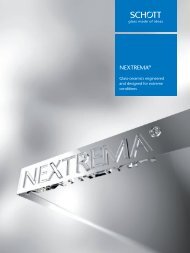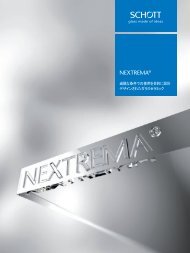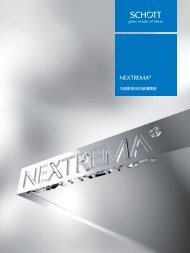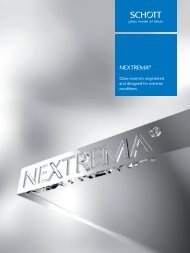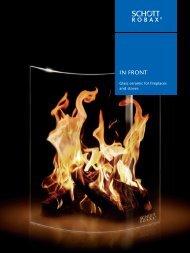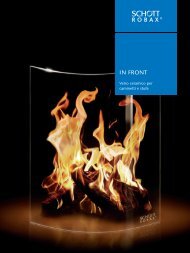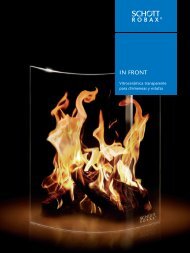SCHOTT Technical Glasses
Apart from its application in optics, glass as a technical material has exerted a formative influence on the development of important technological fields such as chemistry, pharmaceutics, automotive, optics, optoelectronics and information technology. SCHOTT Technical Glasses offers pertinent information in concise form. It contains general information for the determination and evaluation of important glass properties and also informs about specific chemical and physical characteristics and possible applications of the commercial technical glasses produced by SCHOTT. With this brochure, we hope to assist scientists, engineers, and designers in making the appropriate choice and make optimum use of SCHOTT products.
Apart from its application in optics, glass as a technical material has exerted a formative influence on the development of important technological fields such as chemistry, pharmaceutics, automotive, optics, optoelectronics and information technology. SCHOTT Technical Glasses offers pertinent information in concise form. It contains general information for the determination and evaluation of important glass properties and also informs about specific chemical and physical characteristics and possible applications of the commercial technical glasses produced by SCHOTT. With this brochure, we hope to assist scientists, engineers, and designers in making the appropriate choice and make optimum use of SCHOTT products.
Create successful ePaper yourself
Turn your PDF publications into a flip-book with our unique Google optimized e-Paper software.
16<br />
Time and size dependence<br />
For testing and applying tensile strength values, the time<br />
dependence of the load and the size of the surface area<br />
exposed to the stress are particulary important.<br />
As a result of subcritical crack growth due to stress corrosion,<br />
a long lasting tensile stress may boost critical surface flaws,<br />
thus reducing the residual strength with time. Hence the<br />
strength of glass and glass-ceramics is time-dependent!<br />
Stress corrosion causes the dependence of the measured<br />
fracture probability on the stress rate as depicted in Figure 8.<br />
Static fatique<br />
Fracture analyses of broken specimens for the initial flaw,<br />
its origin and growth kinetics yield further information<br />
about the time dependence of the strength of glasses and<br />
glass-ceramics. Some rules are established for estimating<br />
the strength for a permanent load from fast tests with a<br />
constant load rate, see Figure 9 for example. As a simple<br />
rule, the permanent strength (for years of loading) will only<br />
amount to about 1/2 to 1/3 of the strength measured in<br />
fast experiments.<br />
Size dependence<br />
Increasing the stressed area increases the probability of low<br />
strength flaws within this area. This relationship is important<br />
for converting of experimental strengths, which are mostly<br />
determined using small test specimens, to large glass articles<br />
such as pipelines, where many square meters of glass may<br />
be loaded (Figure 10).<br />
Strengthening<br />
The defects that reduce the strength of the surfaces become<br />
ineffective if the glass surface ist subjected to compressive<br />
stress. The resulting strength of a glass article may be so<br />
high that it virtually sets no limits to technical applications.<br />
In glass articles with simple geometries, for example flat<br />
glass, the entire surface of the article can be put under compressive<br />
stress.<br />
The toughening can be caused by rapid cooling (quenching)<br />
of the softened glass (Figure 11) or, in suitable glasses,<br />
by an ion exchange in an approximately 50 – 200 μm thick<br />
surface layer. In subsequent external loading (tensile or<br />
bending), the externally induced stress adds to the internal<br />
stress. Up to the value of the compressive surface stress,<br />
99<br />
95<br />
80<br />
60<br />
50<br />
40<br />
large<br />
small<br />
grain<br />
size<br />
without deliberate<br />
damage<br />
nominal strength<br />
values for<br />
99<br />
normal<br />
glass 95<br />
constructions<br />
80<br />
chem.-<br />
techn.<br />
largescale<br />
units<br />
60<br />
50<br />
40<br />
.<br />
σ = 0,01<br />
0,1 1 10 100 1000 MPa/s<br />
20<br />
20<br />
10<br />
10<br />
6<br />
4<br />
2<br />
1<br />
F in % ––><br />
6<br />
4<br />
2<br />
1<br />
F in % ––><br />
3<br />
5<br />
A<br />
7<br />
10<br />
B<br />
20<br />
30<br />
50<br />
70<br />
100<br />
200 300<br />
σ E in MPa ––><br />
3<br />
5<br />
7<br />
10<br />
20<br />
30<br />
50<br />
70<br />
100<br />
200 300<br />
σ E in MPa ––><br />
A: nominal strength values for chem. techn. large-scale units<br />
B: … and for normal glass constructions<br />
Fig. 8. Failure probability F of a predamaged surface for various rates<br />
of stress increase σ˙ . (predamaged area: 100 mm 2 , grain size: 600)<br />
Fig. 7. Failure probability F for samples abraded by various size grains;<br />
predamaged surface area: 100 mm 2 , rate of stress increase σ˙ = 10 MPa/s






